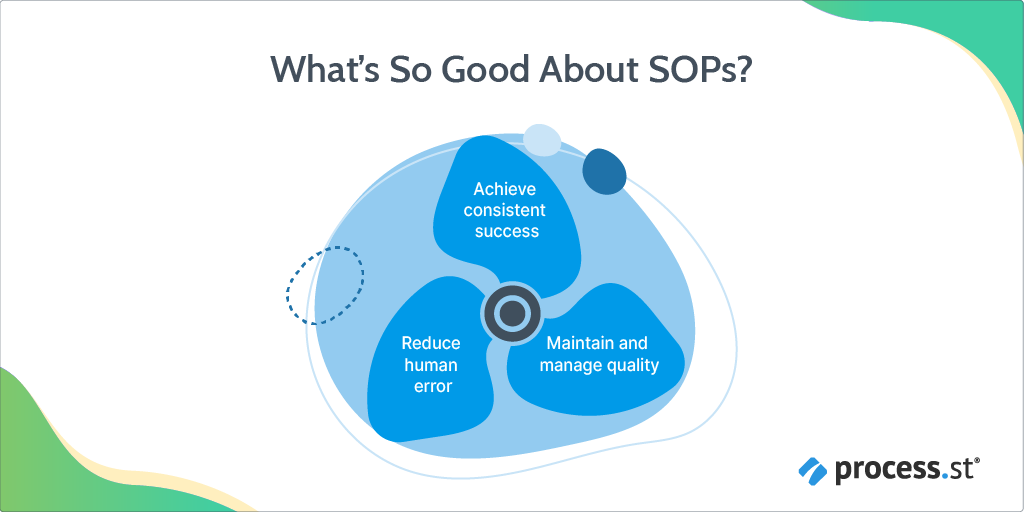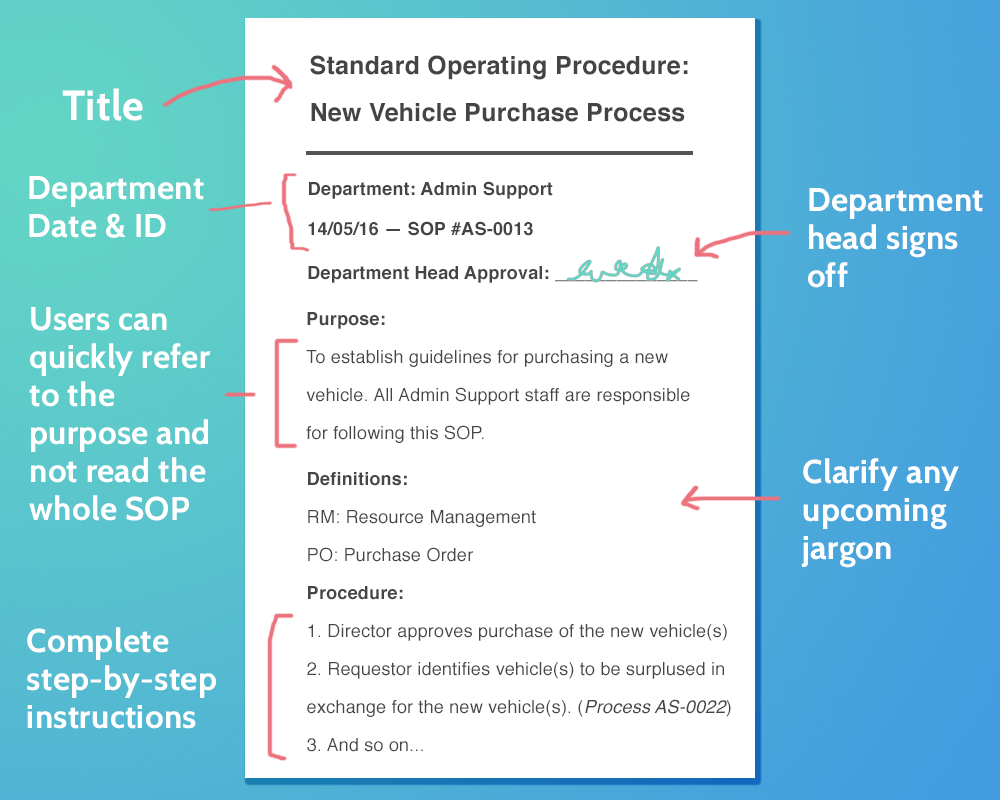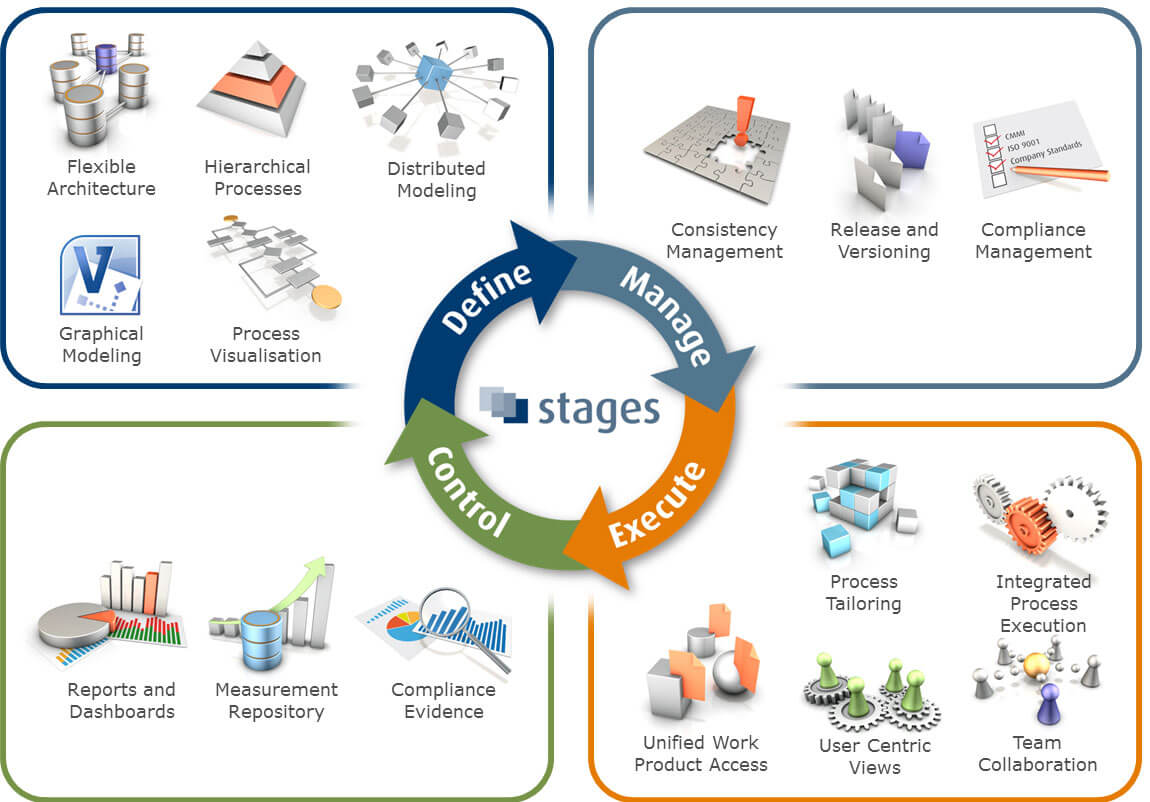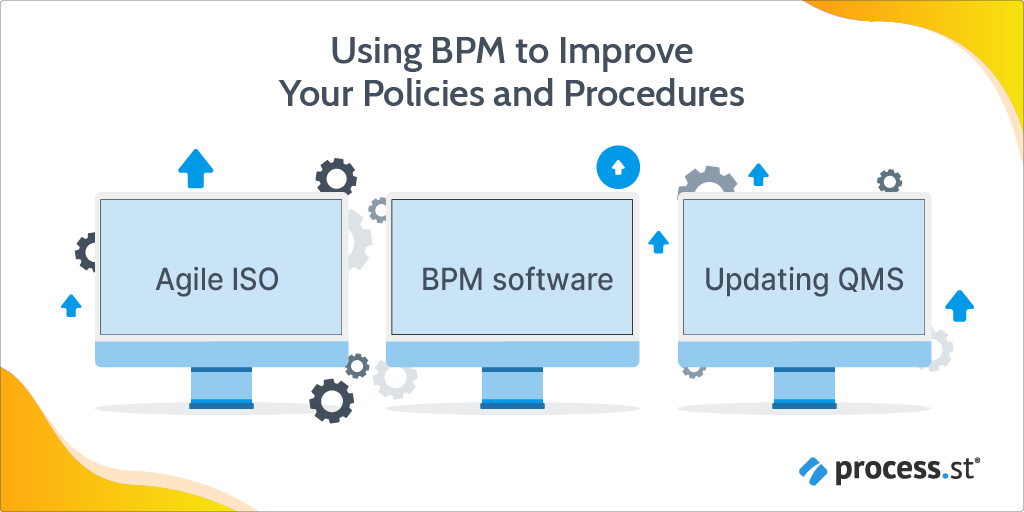
Let’s get straight to the point – you’re probably searching for a policy and procedure template you can use.
Moreover, if you want an actionable policy and procedure template, you can find two hand-crafted examples below. One is a blueprint you can use to build your own, and the other is a filled-out example of the first, using a fictional company called Brightstar Marketing.
In fact, both can be easily edited and updated by you inside Process Street.
Policy and procedure template
The policy and procedure template structure is for you to use as a blueprint. Think of it as a skeleton to flesh out and support your own QMS mini-manual. Equally important, the placeholder text in this template gives instructions on the content needed.
Below is an example of what the above template structure might look like once it’s filled in, using the fictional Brightstar Marketing company. To clarify, use it as a reference point for how to fill out and use your template appropriately.
Now that we’ve dealt with the elephant in the room, I’ll take a little time to break down a few strategies for improving standard operating procedure (SOP) implementation. I will do this using the tools and techniques of BPM (business process management).
No doubt you understand the power of SOPs. For this reason, you might already have some experience implementing them in your business. More to the point, you realize that traditional SOP implementations aren’t good enough.
The truth is, SOPs can be huge detriments to your business. It all depends on how you’re using them. Essentially, that’s why your policy and procedure templates must be actionable.
The problem of using paper for policy and procedure documents

Paper documentation makes procedural change incredibly slow and severely limits your process management capabilities. In other words, it’s near impossible to automate anything that way.
Luckily, since the 2015 revision of the ISO 9001 specification, it’s never been easier to make your SOPs highly actionable and even automated while still adhering to the highest standards in town!
Using Process Street, you can now be ISO compliant and do everything you need with one piece of free, easy-to-use, quick-to-learn software.
In this Process Street article, we’ll cover:
- What’s so good about SOPs?
- Why traditional SOPs can be limiting
- Introducing BPM (business process management)
- Using BPM to improve your policies and procedures
- Practically applying BPM to your policy and procedure template
What’s so good about SOPs?

Correctly implemented SOPs allow you to:
- Achieve consistent success
- Assign different tasks within a workflow
- Guarantee compliance
- Lower costs across the board
- Maintain and manage quality
- Reduce human error
- Save time and money in general
- Support good workflows
- Use them
Nevertheless, how do you define a “properly implemented SOP”?
Properly implemented SOPs

Certainly, all SOPs are different. The specific implementation will depend on the nature of that particular process. On the contrary, your SOPs should always reflect your business goals.
How you approach documenting and implementing your SOPs will often come down to the waterfall vs. agile debate.
Some of your procedures will require extensive planning, whereas others are perfectly functional with zero prep time, forming an ongoing process of experimentation and repetitive improvement.
A “properly implemented SOP” is an SOP that works. Much of the time, traditionally implemented SOPs, with all their belabored ISO compliance, end up being of little to no use due to their unwieldy nature.
Why traditional SOPs can be limiting

Many companies don’t follow their SOPs because they exist in massive, dusty process manuals that are difficult and unwieldy to use.
More to the point, they’re also difficult to improve or change. Even the slightest change requires that the entire manual be redistributed to everyone using it. As a result, it’s a logistical nightmare (not to mention a waste of paper).
If you have SOPs but are not following them, there’s a good chance you aren’t employing backup quality management systems. Due to that, you could be in a worse position than someone who doesn’t even have SOPs.
Crazy, I know!
If not appropriately implemented, SOPs can do more harm than good, meaning you risk:
- Erosion of or distraction from quality standards
- Heightened costs for specialized training
- Increased human error
- Nobody reads or uses them
- Wasted time and money at every step along the process
When discussing “poorly implemented SOPs,” it’s essential to be clear about what constitutes good SOPs.
Introducing BPM (business process management)

Business process management can be potent. However, just as with SOPs, it depends on how you handle them.
Well-implemented BPM allows you to:
- Achieve compliance
- Boost productivity
- Change and scale your processes with agility
- Gain competitive advantage
- Improve customer satisfaction
- Increase revenue
- Mitigate risks
- Reduce costs
Using BPM to improve your policies and procedures

Using BPM to build, manage, and deploy ISO-compliant SOPs can be called Agile ISO.
The principle of Agile ISO is simple: to streamline ISO compliance using the tools and principles of BPM.
Agile ISO means being able to quickly and effortlessly build and modify new processes. You can collaborate with others to develop a robust process library that is actionable, automated, effective, and efficient. Overall, Agile ISO avoids many of the pitfalls of traditional SOP implementation.
Process Street for agile ISO
Process Street is a tool that lets you – quickly and easily – create, standardize, and share workflow processes and procedures. For this reason, you can achieve actionable, fully compliant SOPs with a single piece of software.
Templates in Process Street are containers for the policies and procedures in your company. You can use templates, like the ISO-9000 Structure Template below, to maintain a Quality Management System (QMS). Significantly, you can manage and run the individual workflows and procedures that are part of that QMS.
You’ll be more in control of logistics and tracking completed work across your company. In fact, procedures work as individual checklists. You can then track them with the Inbox and Template Overview features.
Documenting and maintaining your policies and procedures is also incredibly easy with Process Street’s intuitive template editing system. In particular, you can rapidly update and collaborate with others on the processes you build.
BPM software enhances the process of maintaining and updating the QMS
Presently, quality management systems function to align business operations to maintain standards of quality. But, if a QMS standard or record is incorrectly published, traditionally correcting that error (or simply improving on an existing QMS) is a prolonged and laborious process.
Generally, quality management systems are usually more complicated than the graphs and diagrams used to convey them. You can break a QMS down into three main parts:
- Document how each process in your business works and what business goal that process is trying to achieve.
- Log all the ways you could potentially improve the processes in your business.
- Record everything you’ve done, especially things you’ve changed during this improvement process, and update the processes documented in step 1.
You can then repeat the above three steps ad nauseam.
Many organizations like to use quality management systems because they can flaunt all sorts of diagrams and charts showing all the different parts of the business working together. However, maintaining an extensively documented QMS alone does not mean your business is ISO 9001 compliant. Essentially, the QMS must be functional (read: working) throughout the company.
With Process Street, your QMS can be easily edited with new information and shared between interested parties. As a result, employees can easily make changes when necessary. You can then reduce the sluggish bureaucracy typical at this level of corporate regulation.
So far, I’ve been entirely theoretical, so let’s look at some more practical examples.
ISO-9000 Structure template: The ultimate policy and procedure template
The template below will help you build standard operating procedures in line with ISO-9001:2015 specifications for QMS Mini-Manual.
It is a quality management system and a set of quality assurance policies.
Practically applying BPM to your policy and procedure template
The 2015 revision of the ISO 9000 standard added a bunch of scopes which meant companies had more flexibility and agility than ever in getting ISO certified.
In the meantime, please fill out the above template containing your company quality policies and procedure overviews. You can use that template as the central reference guide for all the processes in your organization.
Each procedure overview can link to the relevant, actionable Process Street template for that procedure. Employees can then follow the process as a checklist, which means there is a record – of every time a procedure runs.
Those actionable processes operate as procedures, work instructions, and forms. So an employee knows what they’re doing. In other words, they know how to do it and can provide evidence of their work on the checklist.
Suppose you want to look at Process Street’s actionable processes? In that case, you can jump to the end of this article, where we have provided links to every procedure mentioned in our fully built-out policy and procedure template example, shown right here:
What an actionable mini-manual looks like
Below is a fully built-out mini-manual using the ISO 9000 structure template above.
The mini-manual can be turned into a handy report using Process Street’s export to .pdf feature. The result will look something like this:
7 tips for writing quality policies
A well-written quality policy should aim to incorporate as many of the following points as possible:
- A constant process for quality assessment and improvement
- A quality policy for the whole company
- An understandable picture/map of your organizational structure (including roles and responsibilities)
- Clear and concise language
- Defined business and quality goals
- Documentation of efforts of process/quality improvement
- Unambiguous, actionable documentation of your main operating processes (like a process manual)
16 tips for writing standard operating procedures
In summary, SOPs must be well-written to be effective. The process described should be concise, easy to read, and laid out in a clear step-by-step format. Overall, the information needs to be unambiguous and not overly complicated, especially when there are instructions to be dictated.
Below are 16 informal steps that can function as guidelines for writing your SOPs. While informal, they are just as well-suited to an ISO 9001 standard framework as they are for your more casual SOP requirements:
- Understand how you will present your SOPs
- Gather the relevant stakeholders
- Work out your purpose
- Determine the structure of your SOP
- Prepare the scope of the procedure
- Employ a consistent style
- Apply correct notation, if applicable
- Work through all the necessary steps of the process
- Try to assess potential problems in the process
- Decide on which metrics will measure SOPs
- Test the process
- Send the process to superiors
- Clarify the method of optimizing the process
- Run a risk assessment on the process
- Consider creating a flow diagram
- Finalize and implement the SOPs
For a more in-depth look at these steps, check out this article on writing standard operating procedures.
All the processes our digital marketing company uses in its mini-manual
Below I’ve listed all of the processes documented in the fleshed-out mini-manual. You could try them in your Process Street free account. You can click through each of these processes to find one you might use in your business:
- PPC Audit Checklist
- Performance Marketing (PPC) Keyword Competition Analysis Checklist
- PPC Daily Campaign Review Checklist
- New Facebook Ads Creation Checklist
- Daily Standup Meeting Checklist
- SEO Checklist: The Keyword Research Process
- Google Analytics Audit
- Technical SEO Audit
- Sprint Turnover Process
- PPC Weekly Campaign Review Checklist
- Sprint Retrospective Process
- Sprint Planning
- Brand Identity Design
- PPC Monthly Campaign Review Checklist
- Graphic Design Process
- Creating an Invoice
- Logo Design Process
- Blog Pre-Publish Checklist
- Content Promotion Checklist
- New Affiliate Onboarding
- Intro to FMEA Template: Failure Mode and Effects Analysis
- Process for Improving a Process
- Accounting Onboarding Procedures
- Expense Management Process
- Accounts Receivable Process
- Accounts Payable Process
- Income (Profit and Loss) Statement Process
- Cash Flow Report
- Balance Sheet Statement Preparation Checklist
- Business Tax Preparation Checklist
- Annual Financial Report Template
I know, we spoil you! Log in to the Process Street platform to browse our premade templates, which you can input directly into your business – and new QMS! – with ease.
Did you agree with the comments about using BPM together with SOPs? Perhaps you are utilizing different techniques to streamline your SOPs and ISO compliance? Let us know in the comments below!







Oliver Peterson
Oliver Peterson is a content writer for Process Street with an interest in systems and processes, attempting to use them as tools for taking apart problems and gaining insight into building robust, lasting solutions.